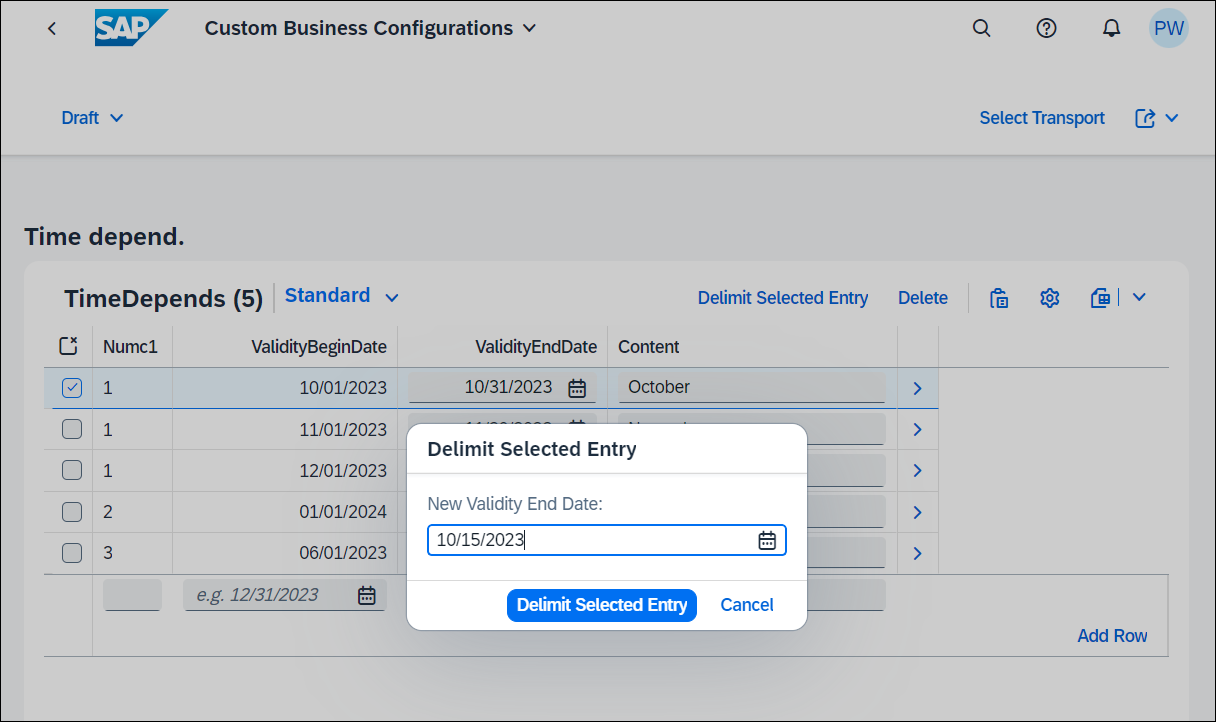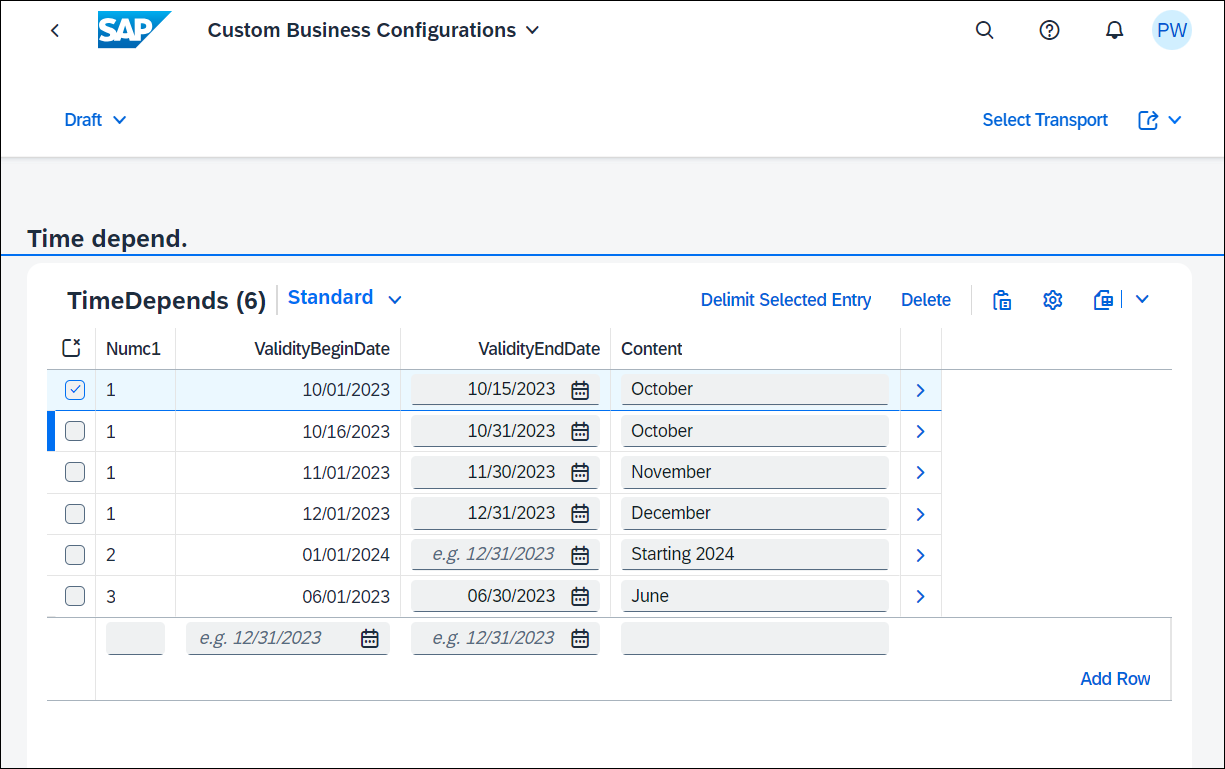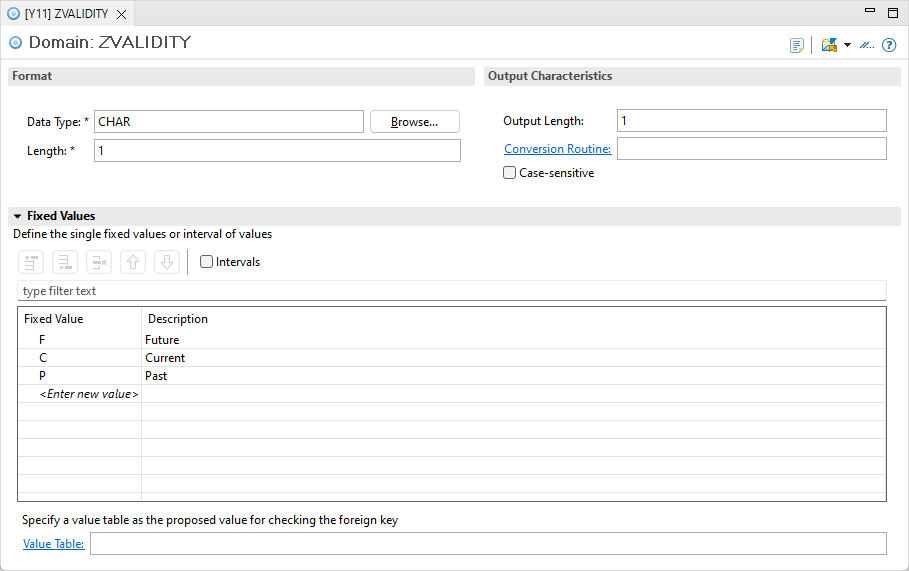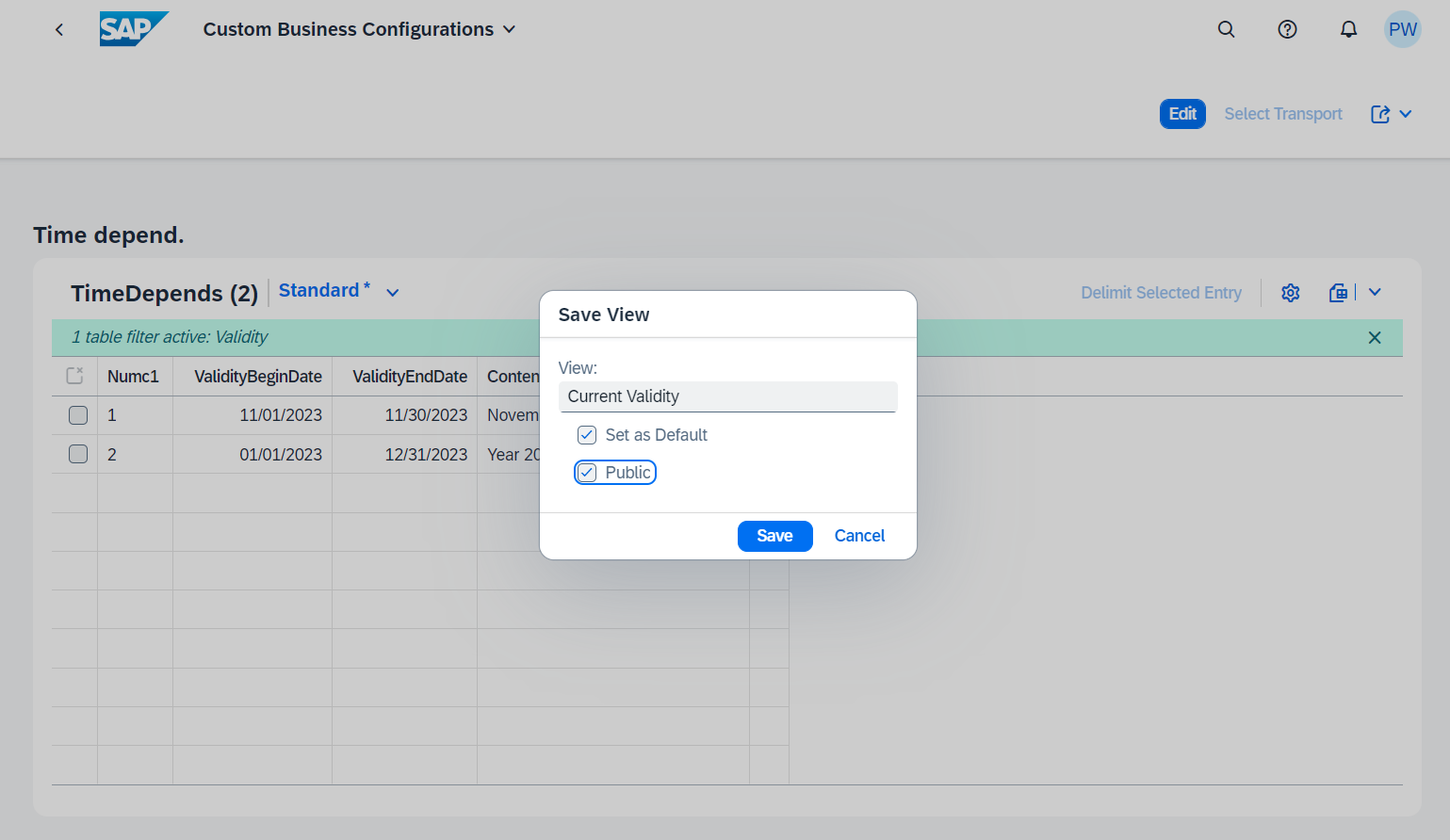
- SAP Community
- Products and Technology
- Technology
- Technology Blogs by SAP
- How to create a Fiori Elements App for a Time-Depe...
- Subscribe to RSS Feed
- Mark as New
- Mark as Read
- Bookmark
- Subscribe
- Printer Friendly Page
- Report Inappropriate Content
Introduction
In this blog post, you will learn how to create a Fiori Elements app for a Time-Dependent RAP Business Object.
Time dependency means that the underlying table has a date that represents the start or end of the record validity as a key field.
Our goal is to create a Fiori Elements app where
- The user can filter the data based on record validity to display current, past, or future valid entries
- The user can use a delimit action to split an existing time slice
- Validations ensure that only one time slice is valid at any time and that there are no gaps between time slices
To follow this blog, you should be familiar with
- ABAP RESTful Programming Model
- Fiori Elements
This blog is relevant for:
- SAP S/4HANA On-Premises 2023 or higher
- SAP S/4HANA Cloud, Public Edition
- SAP S/4HANA Cloud, Private Edition
- SAP BTP, ABAP Environment
Generate RAP BO for time-dependent customizing table
The time-dependent table has the following definition:
@EndUserText.label : 'Time depend.'
@AbapCatalog.enhancement.category : #NOT_EXTENSIBLE
@AbapCatalog.tableCategory : #TRANSPARENT
@AbapCatalog.deliveryClass : #C
@AbapCatalog.dataMaintenance : #ALLOWED
define table ztimedep {
key client : abap.clnt not null;
key numc1 : abap.numc(1) not null;
key validity_begin_date : abap.dats not null;
validity_end_date : abap.dats;
content : abap.char(30);
last_changed_at : abp_lastchange_tstmpl;
local_last_changed_at : abp_locinst_lastchange_tstmpl;
}
With the BC Maintenance Object ADT Wizard, you generate the RAP BO for this table. This way, you can also use the Custom Business Configurations app, so you don't need to create a custom Fiori Elements app. You can also create your own custom Fiori app based on the generated service binding if you don't want to use this app. For more information, see this blog. The following modifications can also be made to any existing RAP BO and can be implemented independently of each other.
Time slice validation
Add the following validation to the table entity in the behavior definition. By using the validity date fields as trigger fields, you can ensure that all changes to the time slice are validated. Also add this validation to the preparation action because a draft-enabled BO has been generated and this validation should be executed for the draft instance.
validation ValidateTimeSlice on save { field ValidityBeginDate, ValidityEndDate; }
draft determine action Prepare {
validation TimeDepend ~ ValidateTimeSlice;
}
Note the comments in the code for a detailed explanation:
METHOD ValidateTimeSlice.
DATA check_date TYPE d.
CONSTANTS c_state_area TYPE string VALUE `TimeValidity`.
"Entities can only be read if the key is specified in full
"Validation requires not only the modified entity, but all others with the same initial key
"Therefore, we use the parent entity to retrieve all sibling entities and additionally read ValidityEndDate
READ ENTITIES OF zi_timedepend_s IN LOCAL MODE
ENTITY timedependall BY \_timedepend
FROM VALUE #( ( %tky-singletonid = 1
%tky-%is_draft = keys[ 1 ]-%is_draft ) )
RESULT FINAL(all_keys).
READ ENTITY IN LOCAL MODE zi_timedepend
FIELDS ( ValidityEndDate ) WITH CORRESPONDING #( all_keys )
RESULT DATA(all_entities).
"Sort by ValidityBeginDate
SORT all_entities BY numc1 ValidityBeginDate ASCENDING.
LOOP AT keys ASSIGNING FIELD-SYMBOL(<key>).
"We are using state messages: https://help.sap.com/docs/abap-cloud/abap-rap/state-messages?version=sap_btp
"Therefore, invalidate existing messages first
INSERT VALUE #( %tky = <key>-%tky
%state_area = c_state_area ) INTO TABLE reported-timedepend.
READ TABLE all_entities WITH KEY %tky = <key>-%tky BINARY SEARCH INTO DATA(entity).
DATA(tabix) = sy-tabix.
"Check1: If ValidityEndDate is set, it must be before ValidityBeginDate
IF entity-ValidityEndDate IS NOT INITIAL AND entity-ValidityEndDate < entity-ValidityBeginDate.
INSERT VALUE #( %tky = <key>-%tky ) INTO TABLE failed-timedepend.
INSERT VALUE #( %tky = <key>-%tky
%state_area = c_state_area
%path-timedependall-singletonid = 1
%path-timedependall-%is_draft = <key>-%is_draft
%element-ValidityEndDate = if_abap_behv=>mk-on "to highlight the affected cell
%msg = new_message_with_text( text = `End date is before Begin date` ) ) INTO TABLE reported-timedepend.
CONTINUE.
ENDIF.
"Check2: Since we sorted by ValidityBeginDate, we can read the preceding chronological entity and check for gaps or overlaps.
READ TABLE all_entities INDEX tabix - 1 ASSIGNING FIELD-SYMBOL(<prev_entity>).
IF sy-subrc = 0 AND <prev_entity>-numc1 = <key>-numc1.
check_date = entity-ValidityBeginDate - 1.
IF <prev_entity>-ValidityEndDate <> check_date.
IF <prev_entity>-ValidityEndDate > check_date.
DATA(text) = `Time slices overlap`.
ELSE.
text = `Gap between time slices`.
ENDIF.
INSERT VALUE #( %tky = <key>-%tky ) INTO TABLE failed-timedepend.
INSERT VALUE #( %tky = <key>-%tky
%state_area = c_state_area
%path-timedependall-singletonid = 1
%path-timedependall-%is_draft = <key>-%is_draft
%element-ValidityBeginDate = if_abap_behv=>mk-on
%msg = new_message_with_text( text = text ) ) INTO TABLE reported-timedepend.
ENDIF.
ENDIF.
"Check3: check the following chronological entity
READ TABLE all_entities INDEX tabix + 1 ASSIGNING FIELD-SYMBOL(<next_entity>).
IF sy-subrc = 0 AND <next_entity>-numc1 = <key>-numc1.
check_date = entity-ValidityEndDate + 1.
IF <next_entity>-ValidityBeginDate <> check_date.
IF <next_entity>-ValidityBeginDate < check_date.
text = `Time slices overlap`.
ELSE.
text = `Gap between time slices`.
ENDIF.
INSERT VALUE #( %tky = <key>-%tky ) INTO TABLE failed-timedepend.
INSERT VALUE #( %tky = <key>-%tky
%state_area = c_state_area
%path-timedependall-singletonid = 1
%path-timedependall-%is_draft = <key>-%is_draft
%element-ValidityEndDate = if_abap_behv=>mk-on
%msg = new_message_with_text( text = text ) ) INTO TABLE reported-timedepend.
ENDIF.
ENDIF.
ENDLOOP.
ENDMETHOD.
In the following example, a new record is added, but its time slice overlaps with the existing records. Note that the validation is executed when you save.

Validation example
Delimit action
A typical task is to split or delimit an existing time-dependent record. We provide the user with an action where a record is selected and a new ValididyEndDate is provided by the user. The existing data record is adjusted with the specified date and a new data record is also created.
Create a new abstract entity for parameterizing the action:
@EndUserText.label: 'Delimit'
define abstract entity ZD_DELIMITTP
{
@EndUserText.label: 'New Validity End Date'
ValidityEndDate : abap.dats;
}
Add the following action to the table entity in the behavior definition and, if applicable, the behavior projection. Also, add a side effect so that the table is refreshed when the action is applied to multiple rows.
"behavior definition
factory action ( features: instance ) Delimit parameter ZD_DELIMITTP [1];
side effects
{ action Delimit affects entity _TimeDependAll; }
"behavior projection
projection;
strict;
use draft;
use side effects;
use action Delimit;
Add the action to the metadata extension:
@UI.identification: [ {
position: 1 ,
label: 'Numc1'
} ]
@UI.lineItem: [ {
position: 1 ,
label: 'Numc1'
},
{
type: #FOR_ACTION,
dataAction: 'Delimit',
label: 'Delimit Selected Entry'
} ]
@UI.facet: [ {
id: 'ZI_TimeDepend',
purpose: #STANDARD,
type: #IDENTIFICATION_REFERENCE,
label: 'Time depend.',
position: 1
} ]
Numc1;
Note the comments in the code for a detailed explanation:
METHOD get_global_authorizations.
AUTHORITY-CHECK OBJECT 'S_TABU_NAM' ID 'TABLE' FIELD 'ZI_TIMEDEPEND' ID 'ACTVT' FIELD '02'.
DATA(is_authorized) = COND #( WHEN sy-subrc = 0 THEN if_abap_behv=>auth-allowed
ELSE if_abap_behv=>auth-unauthorized ).
result-%action-delimit = is_authorized.
ENDMETHOD.
METHOD get_instance_features.
"The delimitation action shall only be possible for draft entities as the transport selection logic requires a draft entity
result = VALUE #( FOR <key> IN keys (
%tky = <key>-%tky
%action-delimit = COND #( WHEN <key>-%is_draft = if_abap_behv=>mk-on
THEN if_abap_behv=>fc-o-enabled
ELSE if_abap_behv=>fc-o-disabled ) ) ).
ENDMETHOD.
METHOD delimit.
DATA new_timedepend TYPE TABLE FOR CREATE zi_timedepend_s\_timedepend.
DATA modify_timedepend TYPE TABLE FOR UPDATE zi_timedepend.
CHECK lines( keys ) > 0.
READ ENTITIES OF zi_timedepend_s IN LOCAL MODE
ENTITY timedepend
ALL FIELDS WITH CORRESPONDING #( keys )
RESULT FINAL(ref_timedepends).
APPEND VALUE #( %is_draft = keys[ 1 ]-%is_draft
singletonid = 1 )
TO new_timedepend ASSIGNING FIELD-SYMBOL(<new_timedepend>).
LOOP AT keys ASSIGNING FIELD-SYMBOL(<key>).
READ TABLE ref_timedepends WITH TABLE KEY draft COMPONENTS %tky = <key>-%tky INTO DATA(ref_timedepend).
"The new ValidityEndDate must be between the current ValidityBeginDate and ValidityEndDate.
IF <key>-%param-ValidityEndDate < ref_timedepend-ValidityBeginDate OR <key>-%param-ValidityEndDate >= ref_timedepend-ValidityEndDate.
INSERT VALUE #( %tky = <key>-%tky ) INTO TABLE failed-timedepend.
INSERT VALUE #( %tky = <key>-%tky
%path-timedependall-singletonid = 1
%path-timedependall-%is_draft = <key>-%is_draft
%msg = new_message_with_text( text = |{ <key>-%param-ValidityEndDate DATE = USER } is not a valid date for delimit action| ) ) INTO TABLE reported-timedepend.
CONTINUE.
ENDIF.
"new record-ValidityBeginDate = user selected date + 1 day
"new record-ValidityEndDate = reference record-ValidityEndDate
ref_timedepend-ValidityBeginDate = <key>-%param-ValidityEndDate + 1.
INSERT VALUE #( %cid = <key>-%cid
%is_draft = <key>-%is_draft
%data = CORRESPONDING #( ref_timedepend EXCEPT lastChangedAt localLastChangedAt singletonid ) "don't copy technical fields
) INTO TABLE <new_timedepend>-%target.
"reference record-ValidityEndDate = user selected date
INSERT VALUE #( %tky = <key>-%tky
ValidityEndDate = <key>-%param-ValidityEndDate
%control-ValidityEndDate = if_abap_behv=>mk-on ) INTO TABLE modify_timedepend.
ENDLOOP.
IF new_timedepend[ 1 ]-%target IS NOT INITIAL.
MODIFY ENTITIES OF zi_timedepend_s IN LOCAL MODE
ENTITY timedependall CREATE BY \_timedepend
FIELDS ( numc1
ValidityBeginDate
ValidityEndDate
content ) WITH new_timedepend
ENTITY timedepend UPDATE FIELDS ( ValidityEndDate ) WITH modify_timedepend
MAPPED FINAL(mapped_create).
mapped-timedepend = mapped_create-timedepend.
ENDIF.
ENDMETHOD.
In the following example, the record valid for October is delimited:

Delimit Selected Entry

Delimit Action Result
Validity View Variants
The user should be able to filter the entries by their validity regarding a key date:
- Currently valid
- Valid in the past
- Valid in the future
There are two alternative solutions:
- View settings variants
- Calculated or Virtual validity field
View settings variants
The user can use the table view settings to create the required filter conditions.

Filter Conditions for Effective Date Today
For this approach, you must ensure that both ValidityBeginDate and ValidityEndDate are within a reasonable period of time so that Today +/- can be applied. You can change the time slice validation by changing the first check:
"Check1: ValidityBeginDate and ValidityEndDate must be within a reasonable timeframe
DATA(max_date) = CONV d( cl_abap_context_info=>get_system_date( ) + 99999 ).
DATA(min_date) = CONV d( cl_abap_context_info=>get_system_date( ) - 99999 ).
IF entity-ValidityEndDate < entity-ValidityBeginDate
OR entity-ValidityEndDate > max_date.
IF entity-ValidityEndDate < entity-ValidityBeginDate.
DATA(err_text) = `End date must be greather than Begin date`.
ELSE.
err_text = |End date must not be greather than { max_date DATE = USER }|.
ENDIF.
INSERT VALUE #( %tky = <key>-%tky ) INTO TABLE failed-timedepend.
INSERT VALUE #( %tky = <key>-%tky
%state_area = c_state_area
%path-timedependall-singletonid = 1
%path-timedependall-%is_draft = <key>-%is_draft
%element-ValidityEndDate = if_abap_behv=>mk-on "to highlight the affected cell
%msg = new_message_with_text( text = err_text ) ) INTO TABLE reported-timedepend.
CONTINUE.
ENDIF.
IF entity-ValidityBeginDate < min_date.
INSERT VALUE #( %tky = <key>-%tky ) INTO TABLE failed-timedepend.
INSERT VALUE #( %tky = <key>-%tky
%state_area = c_state_area
%path-timedependall-singletonid = 1
%path-timedependall-%is_draft = <key>-%is_draft
%element-ValidityBeginDate = if_abap_behv=>mk-on
%msg = new_message_with_text( text = |Begin date must be greather than { min_date DATE = USER }| ) ) INTO TABLE reported-timedepend.
CONTINUE.
ENDIF.
The user now has the option to set this view as the default view for all and create other view variants, for example, for Valid in the future.

Default view
Calculated or virtual validity field
A field "Validity" is added to the data model that calculates the validity of each record with the system date as the key date. The user can use this field in the filter conditions.
Create a custom domain that represents the different validity values:
Validity domain
Create a custom value help entity for the domain:
"for use in SAP BTP, ABAP Environment or S/4HANA Cloud Public Edition
@ObjectModel.dataCategory: #VALUE_HELP
@AccessControl.authorizationCheck: #NOT_REQUIRED
@EndUserText.label: 'Validity'
@Metadata.ignorePropagatedAnnotations: true
@ObjectModel.resultSet.sizeCategory: #XS
define view entity ZI_ValidityVH
as select from DDCDS_CUSTOMER_DOMAIN_VALUE( p_domain_name : 'ZVALIDITY' ) as Id
association [0..1] to DDCDS_CUSTOMER_DOMAIN_VALUE_T as _Text on _Text.value_low = $projection.Validity
and _Text.language = $session.system_language
and _Text.domain_name = Id.domain_name
and _Text.value_position = Id.value_position
{
@ObjectModel.text.element: ['Description']
key value_low as Validity,
@Semantics.text: true
_Text( p_domain_name : 'ZVALIDITY' ).text as Description
}
"for use in S/4HANA Cloud Private Edition and S/4HANA On-Premises
@ObjectModel.dataCategory: #VALUE_HELP
@AccessControl.authorizationCheck: #NOT_REQUIRED
@EndUserText.label: 'Validity'
@Metadata.ignorePropagatedAnnotations: true
@ObjectModel.resultSet.sizeCategory: #XS
define view entity ZI_ValidityVH
as select from dd07l as id
association [0..1] to dd07t as _text on _text.domname = id.domname
and _text.ddlanguage = $session.system_language
and _text.as4local = id.as4local
and _text.valpos = id.valpos
and _text.as4vers = id.as4vers
{
@ObjectModel.text.element: ['Description']
key domvalue_l as Validity,
@Semantics.text: true
_text.ddtext as Description
}
where
id.domname = 'ZVALIDITY'
and id.as4local = 'A'
and id.as4vers = '0000'
Add a calculated field to the base CDS Entity of the table. It calculates the validity value based on the system date. Use the custom value help entity for value help definition. If you want to add an additional visual indicator for the validity, you can use the criticality annotation.
If you have a projection layer, also add the new field to the projection CDS entity.
In this case, you also have the option to define a virtual element in the projection view instead of the calculated field in the base view. The advantage is that you don't need to define a determination with the same logic as in the CDS view, because the calculation is executed for both the active instance and the draft instance via the annotated ABAP class.
@EndUserText.label: 'Time depend.'
@AccessControl.authorizationCheck: #CHECK
define view entity ZI_TimeDepend
as select from ztimedep
association to parent ZI_TimeDepend_S as _TimeDependAll on $projection.SingletonID = _TimeDependAll.SingletonID
{
key numc1 as Numc1,
key validity_begin_date as ValidityBeginDate,
content as Content,
validity_end_date as ValidityEndDate,
@Semantics.systemDateTime.lastChangedAt: true
last_changed_at as LastChangedAt,
@Semantics.systemDateTime.localInstanceLastChangedAt: true
local_last_changed_at as LocalLastChangedAt,
1 as SingletonID,
@Consumption.valueHelpDefinition: [{ entity:
{name: 'ZI_ValidityVH' , element: 'Validity' }
}]
case
when validity_begin_date <= $session.system_date and ( validity_end_date >= $session.system_date or validity_end_date is initial ) then 'C'
when validity_begin_date > $session.system_date then 'F'
else 'P'
end as Validity,
_TimeDependAll
}
Adapt the draft table by adding the calculated field:
@EndUserText.label : 'ZI_TimeDepend - Draft'
@AbapCatalog.enhancement.category : #EXTENSIBLE_ANY
@AbapCatalog.tableCategory : #TRANSPARENT
@AbapCatalog.deliveryClass : #A
@AbapCatalog.dataMaintenance : #RESTRICTED
define table ztimedep_d {
key mandt : mandt not null;
key numc1 : abap.numc(1) not null;
key validitybegindate : abap.dats not null;
content : abap.char(30);
validityenddate : abap.dats;
lastchangedat : abp_lastchange_tstmpl;
locallastchangedat : abp_locinst_lastchange_tstmpl;
singletonid : abap.int1;
validity : abap.char(1);
"%admin" : include sych_bdl_draft_admin_inc;
}
Add the following determination to the table entity in the behavior definition to update the validity value when the validity dates are changed. A side effect is used so that the validity change is reflected on the UI. If you have a projection layer, reuse the side effect in the behavior projection. If you already have a side effect for the delimit action, simply extend the side effect list.
"behavior definition
determination setValidity on modify { field ValidityEndDate; }
side effects
{ field ValidityEndDate affects field Validity; }
"behavior projection
use side effects;
Implement the determination:
METHOD setvalidity.
DATA modify_timedepend TYPE TABLE FOR UPDATE zi_timedepend.
CHECK lines( keys ) > 0.
READ ENTITIES OF zi_timedepend_s IN LOCAL MODE
ENTITY timedepend
ALL FIELDS WITH CORRESPONDING #( keys )
RESULT FINAL(ref_timedepends).
LOOP AT ref_timedepends ASSIGNING FIELD-SYMBOL(<timedepends>).
INSERT VALUE #( %tky = <timedepends>-%tky
validity = COND #( WHEN <timedepends>-ValidityBeginDate <= cl_abap_context_info=>get_system_date( )
AND ( <timedepends>-ValidityEndDate >= cl_abap_context_info=>get_system_date( ) OR <timedepends>-ValidityEndDate IS INITIAL ) THEN 'C'
WHEN <timedepends>-ValidityBeginDate > cl_abap_context_info=>get_system_date( ) THEN 'F'
ELSE 'P' )
%control-validity = if_abap_behv=>mk-on ) INTO TABLE modify_timedepend.
ENDLOOP.
MODIFY ENTITIES OF zi_timedepend_s IN LOCAL MODE
ENTITY timedepend
UPDATE FIELDS ( validity )
WITH modify_timedepend.
ENDMETHOD.
Set the new field Validity as readonly in the behavior definition:
field ( readonly )
Validity,
SingletonID,
LastChangedAt,
LocalLastChangedAt;
The user can now filter the records in the view settings based on the validity value:

Validity Filter
The user now has the option to set this view as the default view for all:

Default view
If the user expands the ValidityEndDate for an outdated entry, the validity column value is updated once the focus is moved from the ValidityEndDate cell.
You must be a registered user to add a comment. If you've already registered, sign in. Otherwise, register and sign in.
-
ABAP CDS Views - CDC (Change Data Capture)
2 -
AI
1 -
Analyze Workload Data
1 -
BTP
1 -
Business and IT Integration
2 -
Business application stu
1 -
Business Technology Platform
1 -
Business Trends
1,658 -
Business Trends
116 -
CAP
1 -
cf
1 -
Cloud Foundry
1 -
Confluent
1 -
Customer COE Basics and Fundamentals
1 -
Customer COE Latest and Greatest
3 -
Customer Data Browser app
1 -
Data Analysis Tool
1 -
data migration
1 -
data transfer
1 -
Datasphere
2 -
Event Information
1,400 -
Event Information
75 -
Expert
1 -
Expert Insights
177 -
Expert Insights
356 -
General
1 -
Google cloud
1 -
Google Next'24
1 -
GraphQL
1 -
Kafka
1 -
Life at SAP
780 -
Life at SAP
14 -
Migrate your Data App
1 -
MTA
1 -
Network Performance Analysis
1 -
NodeJS
1 -
PDF
1 -
POC
1 -
Product Updates
4,575 -
Product Updates
398 -
Replication Flow
1 -
REST API
1 -
RisewithSAP
1 -
SAP BTP
1 -
SAP BTP Cloud Foundry
1 -
SAP Cloud ALM
1 -
SAP Cloud Application Programming Model
1 -
SAP Datasphere
2 -
SAP S4HANA Cloud
1 -
SAP S4HANA Migration Cockpit
1 -
Technology Updates
6,871 -
Technology Updates
493 -
Workload Fluctuations
1
- Best Practice: Manage User Groups and Permissions in SAP Signavio in Technology Blogs by SAP
- Develop with Joule in SAP Build Code in Technology Blogs by SAP
- 10+ ways to reshape your SAP landscape with SAP BTP - Blog 7 Interview in Technology Blogs by SAP
- Building and delivering AI solutions for both developers and end-users in SAP S/4HANA Public Edition in Technology Blogs by SAP
- Be a Cockroach: A Simple Guide to AI and SAP Full-Stack Development - Part I in Technology Blogs by Members
| User | Count |
|---|---|
| 20 | |
| 11 | |
| 8 | |
| 8 | |
| 7 | |
| 7 | |
| 7 | |
| 6 | |
| 6 | |
| 6 |